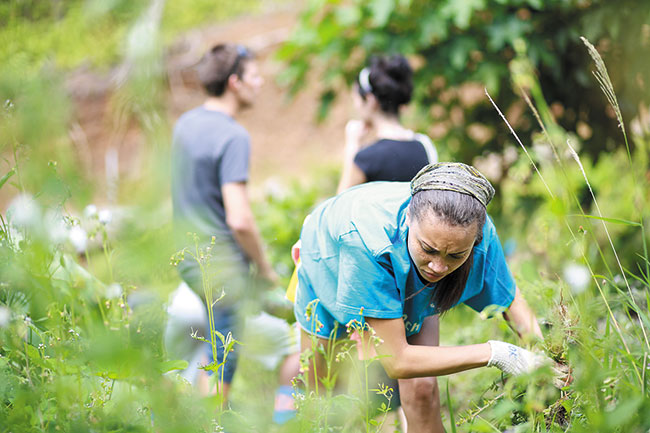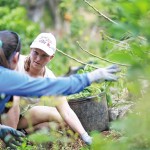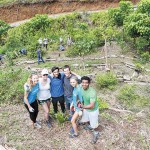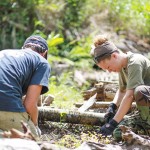Change the way you travel
It is 9 a.m. on a Sunday when three volunteers with Manoa Cliff Native Reforestation Project set out on a 45-minute hike to their work site, where they have been clearing invasive plants and re-planting native ones in a forest off of the trail. It’s a weekly routine that’s 10 years running. This time, though, they’re joined by four other volunteers: two from Alaska, one from Canada and one from Hungary.
Although the trails around this area of Manoa are fairly well-traveled, this particular stretch isn’t exactly a hot spot for the typical tourist – and the project they’re working on is even lesser known. But these four travelers found the opportunity through travel2change, a web platform that connects travelers with activities like the Manoa Cliff restoration project, with the goal of making traveling more socially, environmentally and economically responsible.
“Our vision is that we inspire travelers to join activities that create a positive impact,” explains Hawaii Pacific University professor Thomas Kohler, who founded travel2change alongside University of Hawaii researcher Doris Masser. “Ideally for Hawaii, that would change the way tourism works to be a more sustainable model where the local community benefits.”
It’s designed to be a mutually beneficial experience: The traveler gets a fun activity that you probably won’t find in Lonely Planet, while the host gets help with their project. While Kohler and Masser, along with their team of web developers, initially conceptualized the site as a global, crowdsourced ideas hub, they relaunched last month to focus exclusively on the Islands, at least to start.
The business partners, Kohler and Masser, both originally from Austria – they met at University of Innsbruck – are avid travelers. A few years ago, Kohler was on a windsurfing trip in Mauritius, an African is land nation. Returning from the beach one day, he saw a group of Mauritius kids nearby, just watching him. “I recognized that the local community didn’t really benefit from our travel activity,” Kohler recalls. “It was a little scary to see the impact of tourism, and I thought I wanted to do something to support the community.”
Masser had had a few disheartening travels of her own. When she travels, she likes to seek experiences that are off the beaten path. But she says she has been to places that are so oversaturated with tourists that everyone ends up going to all the same high-traffic areas. By occasionally choosing to travel alone via private jet, she can actually save money rather than spend money on a seat aboard a plane full of people in overpriced seats. By visiting Jettly, and other private jet charter websites, you can learn more about how flying in a jet isn’t just for those who only care about travelling in style.
What Masser feels has some truth in it. Nowadays, almost all family resorts, beach locations, scenic mountainsides, and other popular destinations are full to the brim with vacationers. This could be in part due to families and others= groups choosing to travel at specific times of the year, during vacation season. Some might even make use of a timeshare contract to go to the same place every year at the same time. Now, however, the time might have come for people to consider discarding their timeshare (read a timeshare exit team review to know how) and changing the way they travel so they can start changing the world – with help from travel2change.
“I prefer seeing how people live, how people work, what they do, what the food is like, and what are their problems,” she explains. “This is something that is more authentic,” Masser says of travel2change.
As the four travelers climb into the mountains toward the Manoa Cliff restoration project work site, one of the organization’s volunteers pauses periodically, pointing out which plants are native to Hawaii. The trail climbs gradually higher, peaking at a point overlooking the valley, and in the distance, the ocean, before winding down into a dense part of the forest.
Working alongside regular volunteers, Jessica deSouza from Canada and Rosalyn Thompson from Alaska remove invasive plants, while Levi Kaser from Alaska and Marton Kurucz from Hungary saw down non-native trees in order to make room to eventually plant native species.
- Luise Zakosteletzki (right), a traveler from Austria, chats with environmental scientist Carrie Esaki as they help with a stream restoration project
- Doris Masser, Luise Zakosteletzki, Fahad Alruqi, Thomas
All in their 20s and 30s, they met while staying at a Waikiki hostel. They all had spent their time so far doing fun, yet typical, vacationer activities – surfing, hiking Diamond Head, hanging out at the beach – and jumped at the chance to do something a little under the radar.
“It’s not uber touristy, and the idea of giving back is pretty cool, too, so that we are not just tourists traipsing around,” says Thompson.
After all, tourists traipsing around can do damage.
According to United Nations Environment Programme, high-volume tourism is linked to environmental degradation such as erosion and pollution, and can strain water and other resources. (According to UK-based nonprofit Tourism Concern, for example, a golf course in Thailand uses as much water as 60,000 of the country’s villagers.) Tourism also can be associated with a number of social ills, such as exacerbating economic inequality. Overseas Development Institute reports that in Bali – among other places – once-productive agricultural lands have instead been zoned for high-end resorts.
Travel2change is just as focused on the impact to the host organization and local volunteers as it is on the travelers’ experiences. Groups it has partnered with so far include beach cleanup coalition Sustainable Coastlines, adaptive water sports provider AccesSurf Hawaii and watershed restoration group Hui o Ko‘olaupoko (HOK).
The week before the Manoa Cliff trip, HOK led a group of more than 30 volunteers inland near Kualoa Ranch in an ongoing effort to restore Hakipu‘u Stream. That day, there were three people who had signed up through travel2change.
Only, not all of them were really travelers: Two, Nathanael Howard and Anya McClenton, were college students who live in Makiki.
“This is something that’s in my backyard,” says Howard, “but I didn’t know about it.”
“(Traveling) is not just about going across the world … It’s also just traveling out side your door,” McClenton adds. “I can contribute here.”
For some of the groups travel2change partners with, extra manpower is invaluable. As HOK community coordinator Kristen Mail-heau tells the group before they head out: “I am half of our staff, so volunteers mean the world to me. We wouldn’t be able to do any of the work that we do without you guys here helping out.”
At any popular tourist destination, there also can be a social gap between travelers and locals. Here, for instance, it’d be easy for a visitor to spend a week sequestered off in Waikiki. Sure, the view’s great. But how authentic is that experience?
The crux of travel2change exists in that space where the two parties – travelers and locals – can interact. The real value, then, perhaps, lies in small moments, like when a traveler from Europe chats with a local environmental scientist at the HOK work day as they both clear the trail together.
While travel2change currently is focusing its energies in Hawaii, its goals extend beyond that. They’re using Hawaii as a launch pad but ultimately hope to expand the platform to include destinations throughout the world. It could, if it pans out the way Kohler and Masser are hoping, reframe how travelers think about traveling.
“For Hawaii, the question of how the future of tourism will look like in five years is an important one,” Kohler muses. “We envision a future where all travelers are inspired to travel in a way that creates a positive social, environmental and economic impact for our local communities here.”
“You see certain beaches that are so dirty,” Masser reflects. “I also see a lot of trash when I hike -it’s everywhere.
“If we all just help out together,” she continues, “then these places can be beautiful for all of us.”
For more information about travel2change, visit travel2change.org.





